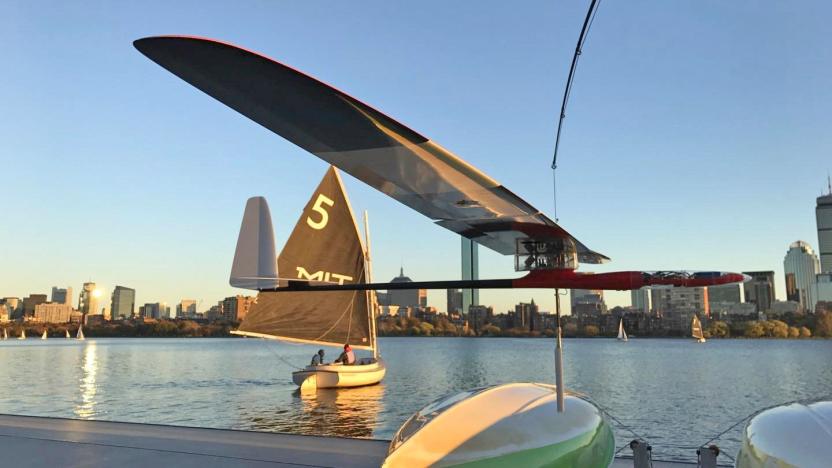sailboat
Latest

MIT's autonomous drone is equal parts albatross and sailboat
"The oceans remain vastly under-monitored," said Gabriel Bousquet, an MIT postdoc who led the design of a unique robot as part of his graduate thesis. "In particular, it's very important to understand the Southern Ocean and how it is interacting with climate change. But it's very hard to get there." Bousquet and his team designed a hybrid vehicle that can both fly above tumultuous seas and sail on them when things are calmer. The vehicle uses one-third as much wind as an albatross would and travels ten times faster than a typical sailboat, making for a very efficient way to survey the vast areas of the planet's seas.

Sailboat racers get a heads-up display to call their own
It's not easy to track the progress of a racing sailboat -- you don't always have the free time (or free hands) to check a compass or run across the deck. Keeping tabs on a watercraft should be much less of a chore in the future, though, as Afterguard has released a heads-up display system for high-speed sailors. The gear relays speed, wind vectors and other boat data from a central unit to any crew member wearing a pair of Recon Instruments glasses, letting a team focus on outrunning the competition rather than getting its bearings. Afterguard isn't cheap at $2,499 for a complete system ($1,899 during April), but you couldn't even get a sailing HUD before now unless you were an America's Cup racer; this makes the technology available to a much wider audience.

Vestas Sailrocket 2 breaks at least one sailing speed record, says motors are for slowpokes (video)
Most of the boats achieving technical wonders these days have motors at their heart, even if they're completely fuel-free. Not so Vestas' Sailrocket 2, which just recently broke the 500-meter sailing speed record. A run across Namibia's Walvis Bay, just longer than the nautical mile the team wanted, saw pilot Paul Larsen officially reach a typical 54.1 knots (62.2MPH) with only wind power to carry him along. The necessary technological breakthough, as you'd suspect, comes mostly through the sail. Since the Sailrocket 2 doesn't have to turn in all directions, it uses an asymmetric wing whose optimized shape and lightweight carbon ribbing produce not only a very efficient power-to-weight ratio, but a seemingly logic-defying amplification effect: the sail catches wind generated by the boat's own speed, magnifying the intensity of any gusts until physics prevent going any faster. The kicker may be a slew of additional records coming in short order. As you'll see in the video after the break, Larsen has already hit unofficial averages of 55.3 knots (63.7MPH) over a nautical mile, 59.4 knots (68.3MPH) over 500 meters and 64.8 knots (74.6MPH) at peak speed. If we could reach that kind of pace on the water, we'd start to look at everyday motorboats as downright antiquated. [Image credit: Helena Darvelid, Vestas Sailrocket]

Avast! 2.1 channel thin-film speaker ship
Music lovin' pirates rejoice, and fill your sails with sound. This 2.1 channel speaker design from FILS features sails made from a next generation thin film, transparent speaker which can be printed or painted with any image. Next up, a Psycho playing shower curtain? Sure, why not.

Robots set sail in Microtransat Challenge
Having already proven their worth on the land in various Grand Challenges, robots are now setting out to conquer the open seas, with the first Microtransat Challenge now getting underway in the Irish Sea off Aberystwyth. From the sound of it, however, this year's competition is just setting the stage for next year's race, when larger boats will set sail from France and hopefully find their way across the Atlantic to the finish line in the Caribbean, relying primarily on wind speed and GPS to stay on track. According to the BBC, the boats will also have to be self-sufficient in terms of energy, and they'll need to be less than 4 meters in length (about 13 feet). No word on what's in store for the winner, but it looks like the competition is still open for anyone looking to give it a shot.[Via Waziwazi]

Vice City's watery playground
It's common knowledge that you'll now be able to play in the water in the PSP's Vice City Stories. Although swimming was introduced in the PS2's San Andreas, this handheld iteration of the popular series will feature the most complex water-based gameplay in the franchise's history, according to IGN. Each vehicle in the game will respond to the game's new water physics model: they'll bob in the water, be affected by currents and be slowed down by drag. (It's like you're buying GTA and getting Wave Race for free.) Using the jet-ski, you'll be able to do drive-by shootings on the water, terrifying rich boat owners. The APV sounds exciting, as you'll be able to drive it around and enter the water when you really need to make a dramatic getaway.With speedboats, yachts, sailboats, zodiacs, airboats, and more, Vice City Stories "might have the largest collection of sea-based vehicles in gaming history," which is especially impressive when you consider the platform's diminuitive size. By making the waterways important to gameplay, gamers can expect tons of mini-games: swimming events, boat and jet ski races. Heck, if you feel like being a good guy and wash your hands of all the sin you're committing, there's no better way than to partake in a water rescue mission. Is anyone else concerned that this game might feature too much content?Vice City Stories hits stores at the end of this month.



